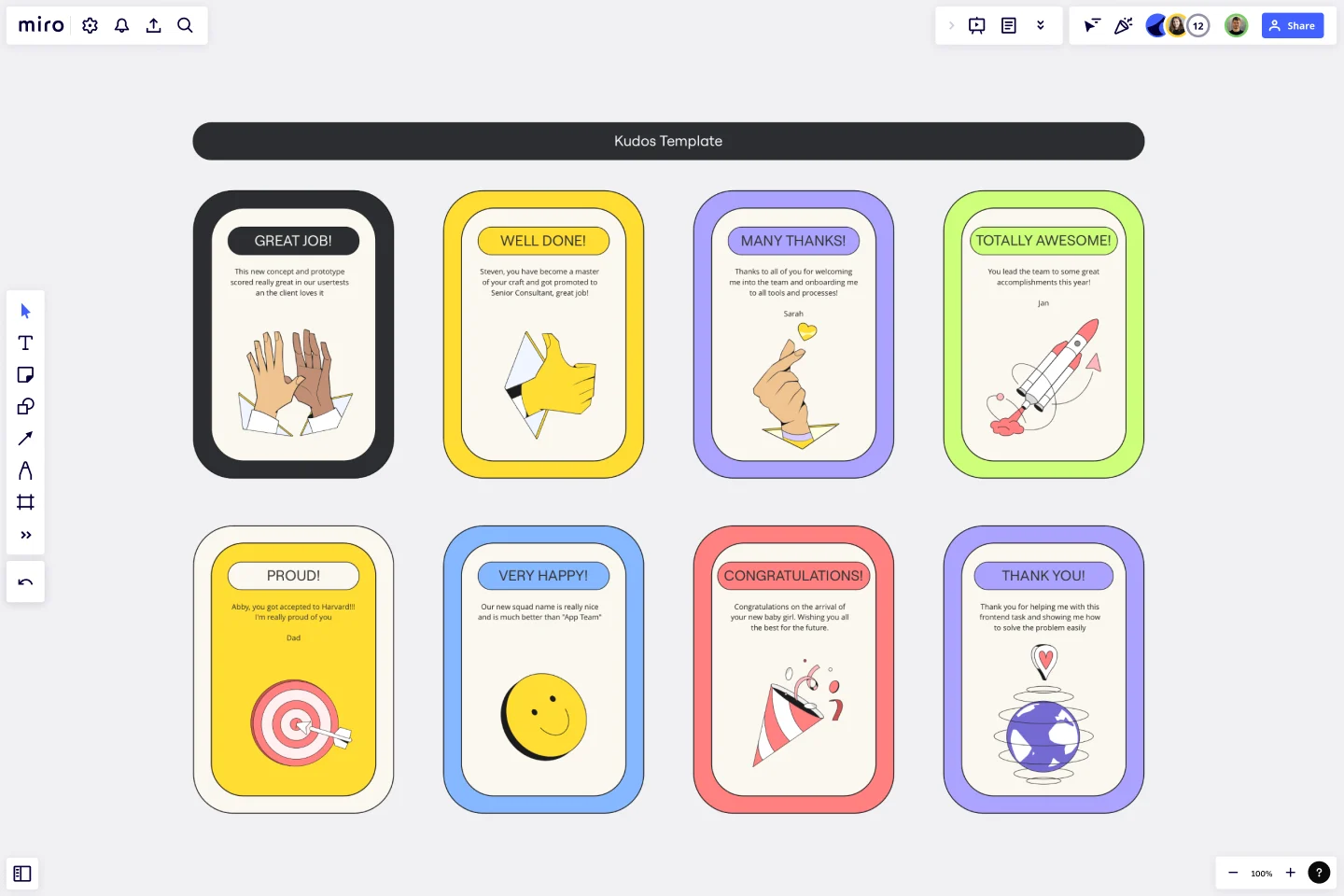Kudos Template
Acknowledge achievements and foster a positive work culture with the Kudos Template.
About the Kudos Template
Recognizing and appreciating the efforts and achievements of team members is crucial to fostering a positive and productive work environment. The Kudos Template facilitates this recognition in a structured and meaningful way. This template is designed to provide a platform for team members to express gratitude, acknowledge accomplishments, and celebrate successes within the team. Highlighting individual contributions helps build morale and encourages a culture of appreciation and support.
How to use the Kudos Template
Using the Kudos Template is straightforward and can be easily integrated into any team's routine:
Choose the template and add it to a shared space accessible to all team members.
Customize the sections to reflect the types of recognition and appreciation most relevant to the team.
Encourage team members to regularly visit the template to acknowledge the contributions of their colleagues by writing notes or leaving messages in the appropriate sections.
Make it a regular practice to review the messages together during team meetings or through shared communication channels to reinforce a positive team culture.
Why should you use a Kudos Template?
Implementing a Kudos Template offers several benefits:
Boosts morale: Recognizing efforts and achievements positively impacts team morale.
Promotes a positive culture: Encourages a culture of appreciation and support within the team.
Increases engagement: Engages team members and motivates them to acknowledge each other's efforts.
Enhances team cohesion: Fosters unity and camaraderie among team members.
Encourages continuous improvement: Recognition of achievements inspires continued excellence and growth.
How often should the Kudos Template be updated?
It's recommended to update the template regularly, such as weekly or monthly, to maintain engagement and momentum in recognizing team members.
Is it suitable for all team sizes?
Yes, the template is adaptable and can be used effectively by teams of any size, from small groups to large organizations.
Get started with this template right now.
Project Review Template
Works best for:
Project Management, Project Review
The Intelligent Project Review Template in Miro is a game-changer for project management. It combines AI-driven insights with interactive features to streamline the review process, making it more efficient and collaborative. One key benefit of this template is its ability to enhance team alignment. By providing a structured format for documenting timelines, hypotheses, target audiences, success metrics, and potential blockers, it ensures that all stakeholders are on the same page, fostering a shared understanding and confidence in the project's direction.
Breakout Group Template
Works best for:
Education, Team Meetings, Workshops
Breakout groups provide an excellent opportunity for teammates to have candid conversations and connect on a more intimate level than is possible during a broader meeting. When you’re in a large group setting, it can be difficult for people to feel safe or comfortable speaking up. In a smaller group, participants can feel safer sharing their ideas. Since the group is more intimate, teams are empowered to participate rather than observe.
Love Bomb Icebreaker Template
Works best for:
Icebreakers
Encourage team members to show their appreciation for each other using Miro’s free Love Bomb Icebreaker Template. Participants can add words or phrases that show what they appreciate about their colleagues.
4 L's Retrospective Template
Works best for:
Retrospectives, Decision Making
So you just completed a sprint. Teams busted their humps and emotions ran high. Now take a clear-eyed look back and grade the sprint honestly—what worked, what didn’t, and what can be improved. This approach (4Ls stand for liked, learned, lacked, and longed for) is an invaluable way to remove the emotion and look at the process critically. That’s how you can build trust, improve morale, and increase engagement—as well as make adjustments to be more productive and successful in the future.
Meeting Reflection Template
Works best for:
Meetings, Brainstorming, Team Meetings
When schedules get hectic, “learning by doing” becomes the default way to learn. So make time for your team to learn in other valuable ways — by reflecting and listening. Led by “learners,” (team members who share with the rest of the team), a meeting reflection lets teammates share new information about a client’s business or an internal business initiative, offer problem-solving techniques, or even recommend books or podcasts worth checking out. Meeting reflections also encourage colleagues at all levels to engage in each other’s professional development of their teammates.
To-do List Template
Works best for:
Project Management, Education, Decision Making
A to-do list helps teams manage, organize, and prioritize their upcoming tasks. As a result, they can improve time management and streamline work operations. Using Miro’s to-do list template, teams create interactive, collaborative, and user-friendly task lists.
